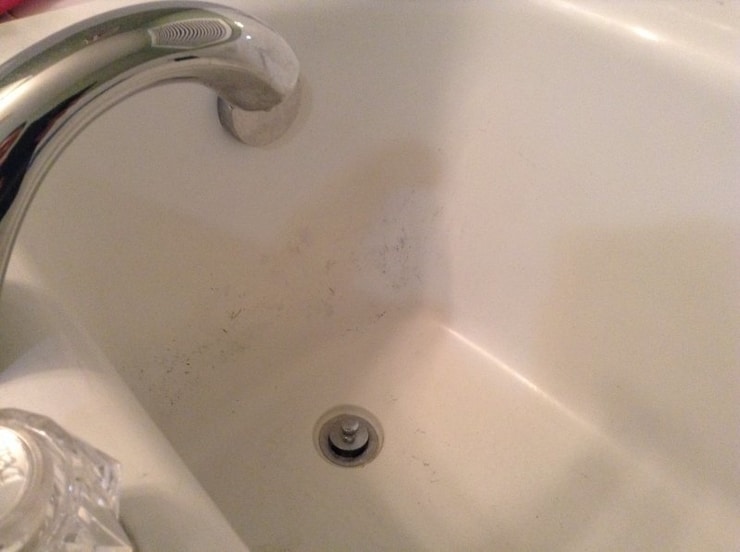Encountering black specks coming out of your tub faucet can be quite alarming, particularly when you realize this is the water used for bathing by you and your family.
Not only do these black flakes pose potential health risks, but they also indicate a significant issue within your home plumbing system.
This article will delve into the reasons behind the presence of these black particles in the water and provide solutions to this problem.

Common Reasons for Black Specks in Your Bathtub Water
If you are noticing black specks coming out of your bathtub faucet, there could be several possible reasons for this issue:
Corroded Water Heater
One of the best ways to determine whether or not your water heater is the cause of black residue in your water is to just turn on your hot water and see if black specks form.
In addition, old water heaters that have not been well maintained can develop corrosion that ends up in your water.
This corrosion can have a domino effect that spreads from your water heater to your pipes and even your faucet.
If left unchecked, this corrosion will eventually cause the breakdown of your water heater, requiring you to purchase a new one.
Sand, Minerals, or Rust In Your Home Water Line
Sand and silt are relatively common for people that get their water from a private well. This sand will appear brown or black and is usually harmless.
Minerals found in your water are usually iron or manganese. These minerals can come from your water source or when certain piping materials react with water. While generally not harmful to your health, these minerals can affect the smell of your water and leave stains on your bathtub.
Rust, while usually appearing brown or red, can also be black. Any rust in your water is a serious issue indicating your pipes or water heater have developed rust. Rust is harmful to your health when ingested or bathed in.
Loose Carbon In Your Water Filtration System
Most people do not use water filter systems for their bathtubs and instead focus on filtration for tap water.
But in some areas where the natural water supply is undesirable, filtration systems are also used for bathing.
Most filtration systems use GAC or granulated activated carbon. This granulated carbon looks like little black specks.
If your filtration system is experiencing issues, this carbon can become loose and end up in your bathwater.
Disintegrating Rubber or Other Broken Parts
If the black flakes found in your water are rubbery or metallic, then a broken part is likely to blame.
Water systems rely on gaskets, washers, and rubber hoses to function correctly. Unfortunately, these vital parts can break off into many small pieces over a long time.
Sometimes these parts just give way due to old age and natural wear and tear.
Other times things like corrosive water or disinfectant used in water supplies can accelerate this decay.
In either case, rubber, plastic, and metal can be harmful, especially if ingested.
How to Get Rid of Black Specks in Bathtub Water
Repairing, Maintaining, or Replacing Your Water Heater
A water heater will generally last for 10 to 15 years.
If you are aware your water heater is near the end of its life or has not been maintained well, you may have to pay for repairs or replacement.
If you are able to repair your water heater on your own, you can save some money and get rid of black specks in your water all in one fell swoop.
Maintaining your water heater is the most optimal solution to keep your water heater running at its best while removing black sediment.
There are many ways to maintain your water heater, including insulation, draining the tank, and testing valves.
Removing Sand, Minerals, and Rust From Your Water Lines
Removing sand from your water lines can be difficult, but the best way is to install a water filtration system that will catch any sand before it ever leaves your faucet. But many water filtration systems can be expensive.
There are a few ways to remove minerals from your water lines, but water softening systems are the most effective way to go about it. Unfortunately, these systems can cost even more than water filtrations systems.
When it comes to rust, you should first inspect your pipes to see how bad the rust is. If the rust is not terrible, you can use enhancement products and water softening to reduce rust. But the most effective way to get rid of rust is to replace rusty pipes.
Removing Loose Carbon From Your Filtration System
Getting rid of loose carbon could be as easy as changing the filter in your water filtration unit.
But if you are having any issues with your water filtration unit, you should consult your manual or contact the manufacturer for more information.
You may change your filters on a regular basis but are still seeing black specks in your water.
This could be caused by faulty filters or a filtration system that’s working improperly.
Getting Rid of Disintegrating Rubber or Broken Parts
Disintegrating rubber and other parts can be brought upon naturally over time or through other cleaners and disinfectants.
The best way to get rid of black stuff made up of broken parts is to replace these parts.
Hoses generally give out first, so this would be an excellent place to start. If your hoses are intact, a close inspection of washers and rubber gaskets should reveal the problem.
Gaskets, washers, and hoses are very easy to replace and are quite inexpensive.

